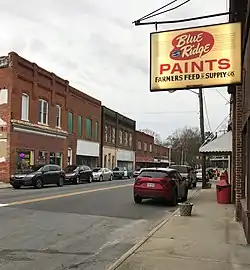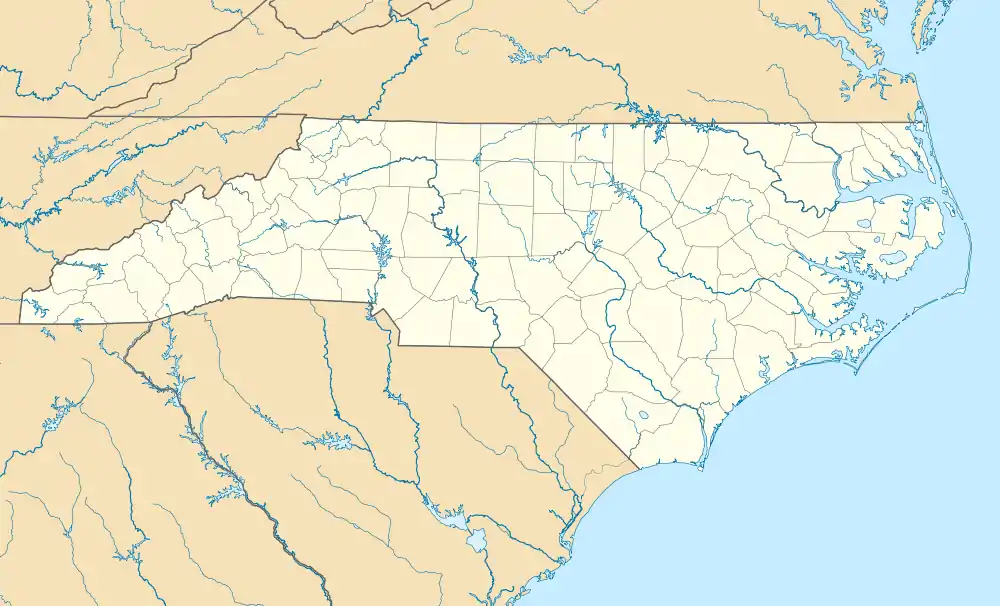Rich Square
Richsquare | |
|---|---|
 Commercial buildings in Rich Square (2020) | |
 Rich Square | |
| Coordinates: 36°16′26″N 77°17′02″W / 36.2739423°N 77.2839064°W | |
| Country | United States |
| State | North Carolina |
| County | Northampton |
| Elevation | 72 ft (22 m) |
| Population | |
| • Total | 894 |
| GNIS feature ID | 2407205[1] |
| Website | richsquarenc |
Rich Square (also known as Richsquare)[2][1] is an American town of 894 people in Northampton County, North Carolina.
History
Quakers were some of the earliest settlers in Northampton County, being established there by the early 1750s. The congregation in Rich Square was established in 1760, and was once a center for the Religious Society of Friends in North Carolina. By 1832, they were a minority in Rich Square, though they continued working to relocate former slaves into free states.[3]
In 1947, Godwin Bush was a black man in Northampton County who escaped a lynching by a white mob; two all-white grand juries refused to indict the seven white kidnappers. In response, local pastor and businessman Paul A. Bishop promoted a black-led boycott of white-owned businesses in Rich Square (contemporaneously described by a black community leader as "a town that didn't like black folk.") Many of the boycotted stores went out of business.[4]
On July 26, 1959, Lieutenant Colonel William Rankin was flying his US Marine Corps F8U Crusader from Naval Air Station South Weymouth in Massachusetts to Naval Air Station Beaufort in South Carolina. When he lost all power at an altitude of 47,000 feet (14,000 m), he ejected into the −70 °F (−57 °C) air and began uncontrolled decompression through an intense thunderstorm and hail for the next 40 minutes. After "the most prolonged and fantastic parachute descent in history", he eventually landed near Rich Square, from where he was rescued by a local farmer and eventually taken to Ahoskie, North Carolina for triage. (The plane came down near Scotland Neck, North Carolina.)[5]
In 1968, the federal government of the United States established the Family Development Training Project in Rich Square, an effort up uplift families in poverty by simultaneously educating all members thereof at government expanse. On a 50-acre (20 ha) parcel of town, twelve training and support buildings were constructed to support the 50 families living in 50 colocated mobile homes. Eligible families must have been employed by two or more employers in the preceding year, and annually earn less than US$2,500 (equivalent to $21,038 in 2022). In 1974, The Family Coordinator called the five-year program "one of the most unique and successful programs ever developed in the United States".[6]
The Duke-Lawrence House is a recognized example of Georgian architecture in Rich Square, and it was added to the National Register of Historic Places in October 1980.[7] The local Holoman-Outland House was recognized for its Colonial Revival architecture and listed on the register in October 2001.[8]
Geography
The town of Rich Square[9] is located in Northampton County, North Carolina, at 36°16′26″N 77°17′02″W / 36.2739423°N 77.2839064°W, with an elevation of 22 meters (72 ft).[1]
Demographics
As of the 2020 United States census, the population of Rich Square was 894 people in 337 of the town's 414 housing units. The median age was 62.2 (± 7.4), with 44.5 percent (± 10.7%) of the town aged 65 or older, and only 9.1 percent (± 4.8%) under 18.[9]
In Rich Square, 4.4 percent (± 4.1%) of residents were foreign-born (all of whom were naturalized citizens), and only 5.0 percent (± 4.4%) spoke a language other than English at home. Four residents (0.4%) were Native Americans, one (0.1%) was Asian, 578 (64.7%) were Black or African American, 26 (2.9%) were Hispanic or Latino, 270 (31.1%) were White people, nine (1%) were of another race or ethnicity, and 24 (2.7%) were multiracial people.[9]
In town, 18.0 percent (± 9.3%) of residents had at least a bachelor's degree, while seven percent had a graduate degree or higher. The employment rate was 38.7 percent (± 13.1%), and 5.5 percent (± 5.7%) of the men were veterans. The town's median household income was $29,375 (± $15,623), as compared to the state's rate of $61,972 (± $541), which left 34.0 percent (± 16.6%) of locals living in poverty.[9]
Government
In the 1960s, Rich Square was governed by a town council. Local funeral home director Joseph Gordon was the first African American elected to the body, in 1967.[10]
Education
In the 1950s, W. S. Creecy High School was located in Rich Square.[4]
Notable residents
- Miles Darden – Alleged largest man in history (1799–1857)[11]
- Florenza Moore Grant – American civil rights activist (1921–2001)[12]
- George V. Holloman – American Army inventor (1902–1946)[13]
- Charles Robert Jenkins – US Army defector (1940–2017)[14]
- Shelia P. Moses – American writer[15]
- James Ransome – American illustrator (born 1961)[16]
- Wesley Tann – African–American fashion designer (1928–2012)[17]
References
- 1 2 3 "Rich Square". Geographic Names Information System. United States Geological Survey, United States Department of the Interior. March 10, 2008. Retrieved May 28, 2023.
- ↑ Payne, Roger L. (1985). Place Names of the Outer Banks. Washington, North Carolina. p. 198.
{{cite book}}: CS1 maint: location missing publisher (link) - ↑ Erickson, Gwendolyn Gosney (Spring 2022). "'This threatful Cloud of iniquity': Rich Square Friends, Rowland Greene, and the Challenge of Slavery in 1832". Southern Friend. 24 (1): 37–50. ISSN 0743-7439.
- 1 2 Gershenhorn, Jerry; Jones, Anna (January 2020). "The Long Black Freedom Struggle in Northampton County, North Carolina, 1930s to 1970s". North Carolina Historical Review. XCVII (1): 1–31. ISSN 0029-2494.
- ↑ Rankin, William H. (October 15, 1960). "I Rode the Thunder". The Saturday Evening Post. Vol. 233, no. 16. pp. 24–25, 45–46, 50, 54, 56. ISSN 0048-9239.
A jet pilot's harrowing account of his high-altitude bail-out through a thunderstorm that held him in its grip for forty minutes after he jumped.
- ↑ Porter, Gwendolyn (April 1974). "The Family Training Concept". The Family Coordinator. Wiley-Blackwell. 23 (2): 171–174. doi:10.2307/581715. ISSN 0014-7214. JSTOR 581715.
- ↑ "Duke-Lawrence House". National Register of Historic Places. National Park Service. Archived from the original on May 28, 2023. Retrieved May 28, 2023.
- ↑ "Holoman-Outland House". National Register of Historic Places. National Park Service. Archived from the original on February 8, 2018. Retrieved May 28, 2023.
- 1 2 3 4 "Rich Square town; North Carolina". United States Census Bureau. Archived from the original on May 28, 2023. Retrieved May 28, 2023.
- ↑ "Rich Square Elects First Negro to Seat on Council". Norfolk Journal and Guide. May 27, 1967. p. 8.
- ↑ Jones, H. G. (March 16, 1977). "The Obscure Miles Darden: In the Light of History". Rocky Mount Telegram. Chapel Hill, North Carolina. p. 24. ISSN 1082-3727. OCLC 31876877.
- ↑ Gerard, Philip (May 28, 2018). "The 1940s: Field of Dreams". Our State. ISSN 1092-0838. Archived from the original on February 5, 2023. Retrieved May 29, 2023.
At a rural crossroads in Halifax County, black farmers chart a new destiny for their families through the Tillery resettlement program.
- ↑ Gallico, Paul (March 25, 1944). "The Three Gadgeteers". The Saturday Evening Post. Vol. 216, no. 39. pp. 16–17, 43–44, 46. ISSN 0048-9239.
- ↑ Ramzy, Austin (December 12, 2017). "Charles Jenkins, 77, U.S. Soldier Who Regretted Fleeing to North Korea, Dies". The New York Times. p. 12. ISSN 1553-8095. OCLC 1645522. Archived from the original on March 12, 2019. Retrieved March 19, 2022.
- ↑ "Georgia Authors: Shelia P. Moses". DeKalb County, Georgia: DeKalb County Public Library. Archived from the original on August 30, 2010. Retrieved May 29, 2023.
- ↑ McElmeel, Sharron L. (May–June 2001), "Illustrator Profile: James E. Ransome", Library Talk, vol. 14, no. 3, pp. 26–27, ISSN 1043-237X
- ↑ Deihl, Nancy (2021). "Wesley Tann: the glamour and the guts". In Way, Elizabeth (ed.). Black Designers in American Fashion. Bloomsbury: Bloomsbury Publishing. pp. 134–150. ISBN 978-1-350-13846-9.
External links
- Official website
 Media related to Rich Square, North Carolina at Wikimedia Commons
Media related to Rich Square, North Carolina at Wikimedia Commons
